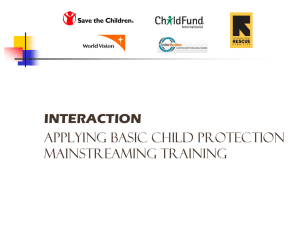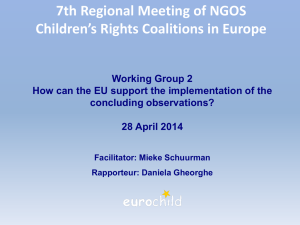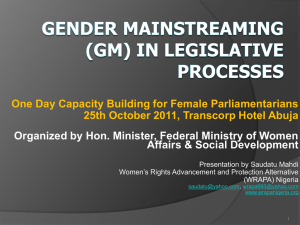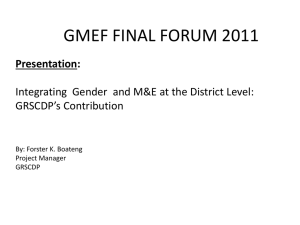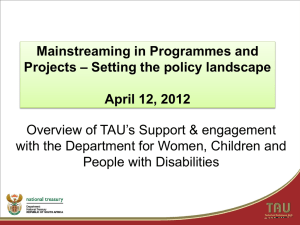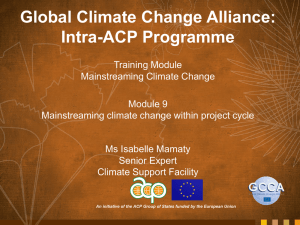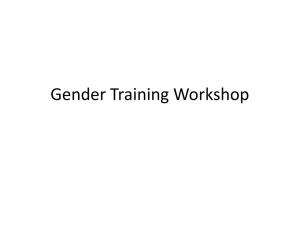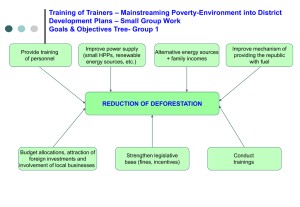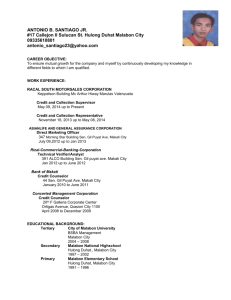Mainstreaming environmental concerns into City Development
advertisement
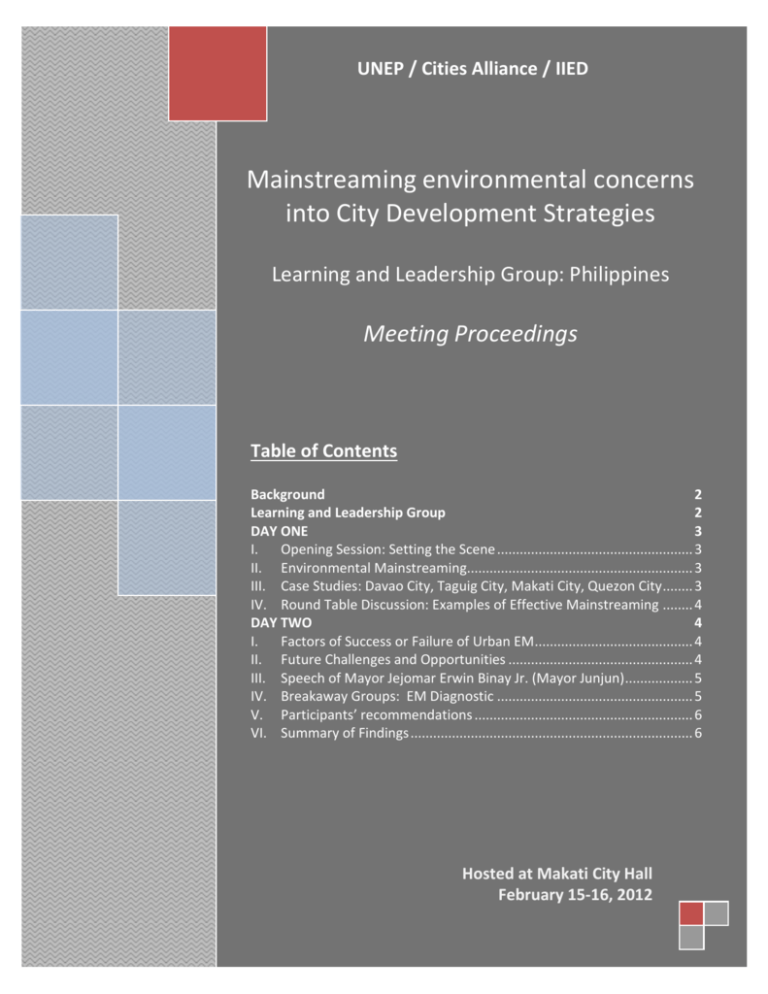
UNEP / Cities Alliance / IIED Mainstreaming environmental concerns into City Development Strategies Learning and Leadership Group: Philippines Meeting Proceedings Table of Contents Background 2 Learning and Leadership Group 2 DAY ONE 3 I. Opening Session: Setting the Scene .................................................... 3 II. Environmental Mainstreaming............................................................ 3 III. Case Studies: Davao City, Taguig City, Makati City, Quezon City ........ 3 IV. Round Table Discussion: Examples of Effective Mainstreaming ........ 4 DAY TWO 4 I. Factors of Success or Failure of Urban EM .......................................... 4 II. Future Challenges and Opportunities ................................................. 4 III. Speech of Mayor Jejomar Erwin Binay Jr. (Mayor Junjun) .................. 5 IV. Breakaway Groups: EM Diagnostic .................................................... 5 V. Participants’ recommendations .......................................................... 6 VI. Summary of Findings ........................................................................... 6 Hosted at Makati City Hall February 15-16, 2012 Background The United Nations Environment Programme (UNEP) and the International Institute for Environment and Development (IIED), with support from Cities Alliance, are working together to develop an approach that will strengthen the incorporation of environmental issues and concerns more effectively in city planning and development processes. As stated in the Millennium Ecosystems Assessment, while urban development trends may pose serious problems with respect to ecosystem services and human well-being, the benefits to human well-being can be substantial when urban systems are managed more equitably and the loss of ecosystem services is purposefully addressed. This activity contributes to this process. The intended outcome of this activity is to achieve better and more effective integration of environmental issues and concerns in city planning and development processes, including City Development Strategies. The activity also has several additional objectives, including increasing awareness of the importance of incorporating the ‘environment’ in urban issues; promoting policies of adaptation to and mitigation of climate change, to field test this approach in cities in Latin America, Asia and Africa. Learning and Leadership Group As part of this programme of work, UNEP, Cities Alliance and IIED organized a ‘Learning and Leadership Group’ to examine these issues in the context of Makati City and Quezon City, Philippines. This was held on February 15-16 2012, and was kindly hosted by Makati City Hall. Objectives In general terms, the workshop aimed to draw a picture of what has been done so far in terms of ‘environment’ and ‘city development’ in the country, and in particular on integrating environmental issues into Makati City and Quezon City’s CDS. Also, it aimed to have a clearer perspective on the future development of the matter, in particular on the environmental pressures that cities in the Philippines face, and on the opportunities in terms of policy making and integration of environment (including climate change), poverty and development concerns in the Philippines’ urban centres. The discussions in the Learning and Leadership Group were informed by a background paper (prepared by Ella Antonio) on ‘Mainstreaming Environment in Development’. Participants Participants in the ‘Learning and Leadership Group’ are respected individuals, the majority of whom were engaged with the development of the City Development Strategy (CDS) process in Makati City and Quezon City, together with others who have been involved with other environmental mainstreaming activities in these local government authorities and elsewhere in the Philippines (A full list of participants can be provided upon request). They all have considerable experience in urban development, poverty reduction, finance, and/or the environment. The workshop was facilitated by IIED (David Dodman and Barry DalalClayton) and supported by Ella Antonio (local consultant). There were a limited number of formal presentations (available upon request), with most of the time dedicated to facilitated discussions. 2 DAY ONE I. Opening Session: Setting the Scene The meeting began with a welcome from Atty Violeta Seva, Special Advisor to Major Jejomar Binay. She described Makati City’s commitment to safer, more sustainable and more resilient communities and stressed the role of Municipalities in the implementation of environmental laws. Soraya Smaoun (UNEP) identified some of the key issues for mainstreaming environmental concerns into city development strategies, and explained some of the activities led by UNEP that support this process. Sharon Gil (UNEP) explained the role of City Development Strategies (CDS), describing them as City Planning PLUS: Peopleoriented and Participatory; Long term; Urban planning in action; and Strategic. David Dodman (IIED) described the relationship between urbanization and urban poverty, explained the way in which urban environmental challenges evolve with different stages of development, and outlined the role of cities in responding to climate change. II. Environmental Mainstreaming Barry Dalal-Clayton (IIED) gave a presentation on the concept and practice of environmental mainstreaming, defined as “the informed inclusion of relevant environmental concerns into the decisions and institutions that drive national, sectoral, city and local development policy, rules, plans, investment and action”. He explained the urgent need for environmental mainstreaming, by presenting a number of environmental challenges and some failures of the environmental movement to generate support. The discussion following this presentation focused on the applicability of an environmental mainstreaming approach to the context of cities in the Philippines, on the environmental tools and methodologies available to cities, and on the factors preventing their use. The existence of comprehensive development plans was seen to be an opportunity, but the absence of permanent institutional structures within many cities was seen as a substantial barrier to getting environmental concerns taken seriously in the planning process. To strengthen the institutional framework in this sense, a possibility is to highlight the extent to which environmental concerns lead to substantial a benefit to cities, rather than to costs, and allow, instead, avoiding other costs III. Case Studies: Davao City, Taguig City, Makati City, Quezon City Four case studies were presented from Davao City, Taguig City, Makati City and Quezon City. The PowerPoint presentations are available upon request. The discussion following these presentations raised and elaborated on several key issues. There was substantial discussion about the way in which processes of environmental change operated alongside broader processes of urban change, including migration, urban sprawl, and economic development. The relationship between different sets of plans and priorities were discussed, with considerable elaboration on the role and contents of the Comprehensive Development Plans. Different institutional mechanisms for bringing stakeholders together were also discussed, such as the Environmental Protection Council in Makati City and the Environment Policy Management Council in Quezon City. Informal settlements were seen as being a key issue facing many cities in the Philippines, and as being an essential element to be addressed within environmental mainstreaming activities. 3 IV. Round Table Discussion: Examples of Effective Mainstreaming The closing discussion focused on the forces resulting in environmental concerns being taken seriously in cities in the Philippines, with academic research and media involvement playing a key role in this process (for example, in relation to biodiversity preservation in Quezon City). It also addressed the types of tools currently being used by cities for addressing environmental issues: these included information tools, greenhouse gas inventories, a disaster risk assessment tool developed by Kyoto University, a waste analysis tool used in Makati City, and the Local Government Performance Management System. DAY TWO I. Factors of Success or Failure of Urban EM During this session participants reflected on the key drivers of success and the key constraints based on the presentations and on the discussion of the previous day. The participants pointed out that networks and alliances among city managers represent a valuable asset. It was also recognized that mobilising partnerships with private actors, the media, and the civil society might be beneficial to ensure the success of the activities. Moreover the participants viewed working with an international institution as an opportunity to mobilise funds for implementing environmental policies. Environmental management is constrained by financial limitations as well as technical expertise to implement adequate policies. This is due to the fact that environmental issues do not always perceived by elected officials as a priority and thus not given a budget. Structural barriers imposed by the existing institutional framework were also pointed out as a factor in many failed policies. Metro Manila experiences, many conflicting competencies and regulations at different levels of government. II. Future Challenges and Opportunities The participants were also requested to identify what they perceive to be future challenges and opportunities represented by trends of environmental improvement and deterioration. The main improvement has been the increased awareness of households, companies and policy makers on the importance of environmental concerns (e.g. reflected in better regulation for the informal settlements). Another area of improvement concerned the better management of solid waste and wastewater. There was some ambiguity over the issue of air quality. While some said that air quality has improved, others believe that air quality has actually gotten worse – a difference in opinion attributed to the very different air quality found in residential areas and around major thoroughfares. It was evident that a better instrument was needed for measuring environmental indicators at the local level. There was a consensus over the deterioration of the local environment particularly on the quality of the water and the protection of biodiversity in the urban periphery. This is especially relevant to Quezon City which is home to a major watershed area/park. 4 III. Speech of Mayor Jejomar Erwin Binay Jr. (Mayor Junjun) Makati Mayor, Junjun Binay, visited briefly to greet the participants and outline Makati’s environmental priorities. The first priority concerns green buildings. The “greening” of the Makati City Hall is in progress focusing particularly on energy efficiency and water consumption, to serve as a model for private sector developers. The city is working on this, and on a draft ordinance on “green buildings”, with the non-profit Verde (Green). The second priority is about poverty and disaster risk reduction (DRR). According to the mayor, the biggest challenge the city faces is the prevalence of poverty, which in turn brings with it many vulnerabilities, among which is vulnerability to natural disasters. Makati is amending its zoning ordinance to address this issue and is pouring more funds for disaster risk reduction. Last but not least, he advocated for greater cooperation and management among Metro Manila cities particularly in the areas of solid waste management and cooperation and slum management. He said that keeping the city clean requires cooperation from neighbouring cities. Reduction of informal settlers is also a challenge, as informal settlers live in the borders and have an impact on Makati’s environment in spite of them not being within the city’s jurisdiction. IV. Breakaway Groups: EM Diagnostic In the afternoon, the participants were divided into two groups to review the self-assessment tool developed by IIED, the Environmental Mainstreaming Diagnostic. The first group (A) looked at Organizational-level mainstreaming and National Approach to EM, and the second group (B) focused on Project Level Mainstreaming. The objective of the exercise was to review the relevance of the tool to cities and the comments of the participants will serve as a basis for work. Organizational Level Mainstreaming: Grateful if Ella could please expound on key discussions from the first group Project Level Mainstreaming. An interesting development during the review of the tool was the attempt of the second group (B) to go beyond reviewing the diagnostic questions and actually used the tool in a specific project such as road development. Different points were raised in the discussion. It was recognised that additional mainstreaming needs to be done, and the institutional structure strengthened for this purpose (e.g. to improve the disconnect between the implementation of national policy and local policy). While Local governments already have simple tools to monitor environmental mainstreaming such as Pasig’s “Certificate of Compliance” tool, the two entry points wherefrom the city government can further intervene were identified as the issuance of a building permit and the issuance of a business license. Feedback Session City Development Strategy. Simultaneously, Soraya Smaoun and David Dodman took the time to interview key officials of Makati (Violeta Seva, Senior Advisor, Office of the Mayor) and Quezon City (Alice Padua, City Planning and Development Division Head) about their respective Comprehensive Development Strategies (CDS) and its utility. It was found that for both cities the CDS is not being used since existing planning documents such as the City Development Plan (CDP) and the Comprehensive Land Use Plan (CLUP) already exist and are mandated by law. The CDS process encouraged Quezon City collaboration with the Asian Development Bank (ADB). For Makati, the value of the CDS was more in terms of capacity building. 5 V. Participants’ recommendations In the light of what above, few recommendations were pointed out. Maintaining and building institutional capacity was seen as a priority. This can be done through training of existing staff and also by providing adequate compensation to attract the right level of expertise. Mobilising and providing incentives for a wide range of actors is also a priority. This includes improving the political leadership, and also further promoting forms of partnership and collaborations with other public actors (other LGU and levels of government), as well as other urban stakeholders. Developing an instrument to appropriately monitor and evaluate is necessary to adopt successful policies and to assess the achievements. These should measure the economic sustainability and the effectiveness of policies, as well as the environmental performance of the city. The best policy instrument that was identified to promote environmental mainstreaming (EM) at the city level is by identifying and taking advantage of existing opportunities in the current context. Pasig pointed out two entry-points where the city government can effectively intervene: prior to the issuance of a building permit and prior to issuance of a business license. VI. Summary of Findings There are important innovative green policies in Metro Manila but there is room for mainstreaming in areas that are not in the purview of the environment office. The main barriers concern not only the lack of financial resources, but also the lack of human resources and institutional capacity. The greatest asset that local authorities have available in the Philippines is the cooperation among different stakeholders and existing networks such as the League of Cities of the Philippines. The meeting identified possible steps forward (e.g. guidelines for the local government; web-resource on environmental mainstreaming). Nevertheless the diagnosis needs to serve as a catalyst for action aimed at further mainstreaming environment concerns in urban policy making. 6
